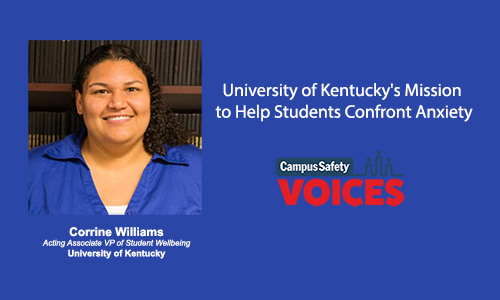Anxiety disorders are the most common mental illness in the U.S., affecting 40 million adults — approximately 15.5% of all Americans over the age of 18. While highly treatable, only 36.9% of those suffering receive treatment, according to the Anxiety & Depression Association of America.
In the last two years, discussions regarding mental health are often intertwined with discussions about the pandemic. When we talk about COVID’s impact on mental health, many envision more serious situations such as the rise in hospitalizations and suicides. While extremely important to consider and continue to study, increases in general anxiety are also a concern — particularly for college-aged students.
Statistics show people ages 18-24 are at higher risk for mental health challenges. In a survey published by the Centers for Disease Control and Prevention (CDC) in Aug. 2020, 69.2% of adults ages 18-24 reported symptoms of anxiety, depression or both. Nearly a quarter also said they had seriously considered suicide.
To diver deeper into these concerning statistics, we spoke to Corrine Williams, University of Kentucky’s (UK) acting associate vice president of student wellbeing, about the stresses that come with the transition to college and how it has been compounded by the pandemic (3:45).
“It’s a period of huge development and transition to independence. And particularly, if you go away from home to college, that’s a pretty abrupt transition. You are going from living with your parents to being fully on your own — being responsible for keeping yourself fed and clothed and all of these things. Even if you have financial support, you are responsible for doing all of that,” Williams told Campus Safety. “There’s also a lot of relationships that develop during this time, both friendships and romantic relationships, that can lead to stress. We do see that a high percentage of our students at some point over their time with us will have some sort of stress, anxiety, or depression. Sometimes it’s passing symptoms, other times it really does reach the level where intervention is needed where you need to talk with professional help.”
‘Low-Level Anxiety’ Is Impacting College Students’ Wellbeing
The pandemic has been difficult for people of all ages but students who are about to be in their second or third year of college also missed out on some of the growth opportunities that typically arise during the latter half of high school.
“What’s been really interesting about our past two cohorts of admitted students is they went from a period of being home with their families — sometimes for very extended periods of time. And some of that beginning to transition to independence that might have happened in those last couple of years of high school, when you think about starting to drive and just being a little bit more out there with your friends, going out in the evenings — some of that didn’t happen because of the pandemic and being safe and cautious,” said Williams. “I do think there has been a little bit more of an abrupt transition to independence right now, and I have talked with students who are really struggling with how do they make new friends and sort of take advantage of the whole college experience while also keeping themselves safe.”
Williams and her staff have noticed an uptick in what she calls “low-level anxiety” (10:18). Even seemingly typical tasks like getting to classes on time have proved challenging for some students. Many became accustomed to simply rolling out of bed and going to their computer to start online classes.
“People are struggling to name what the problem is and we’re trying to then encourage them at that point to seek help,” she said.
To combat these concerns, the school piloted a wellness review last spring which consisted of student messaging that focused on recognizing changes in themselves or their peers.
“It doesn’t mean necessarily looking for specific symptoms [but rather] are you different in some ways than you were before? Are you sleeping differently or are you not eating the same way? Can you point to some physical or other changes that don’t seem normal for you? And that was really what we tried to get people to queue in on because how one person responds may be very different,” said Williams. “Some people might get to a very almost hypomanic, very happy place. And so outward facing, that seems fine — they’re smiling, they’re joking, etcetera. So we really try to get people to look for, is your friend changing in some way that is unexplained? Are they acting differently than they normally act? And having that be our focus because it’s really hard to say right now how any one person is going to react.”
UK also pushes out messaging about coping strategies. If coping strategies a student has in place to get through and manage stressful situations are no longer working, they should reach out for help. When Williams feels stressed, she goes on walks and listens to nature. If she stops doing that, that’s a sign that she needs additional support.
Benefits of Speaking Up About Mental Health Struggles
The silver lining to the increases in anxiety and mental health disorders is that more conversations are happening and more students are seeking help due to a reduced stigma. Williams and her team are finding that a large chunk of students seeking help need support with what Williams calls “expectation management” — something the school is prepared to help students address (22:35).
“What they need help with is more general things like time management [which is] actually the underlying cause of that stress, where they see it as stress and want to talk to someone about it but the actual solution isn’t, for example, therapy,” she said. “To our earlier conversation about that transition to independence and being a college student, how do we figure out how to do all that stuff you have to do now and you’re responsible for on a daily basis and really working through that.”
Williams estimates that 25% of students who seek help don’t actually need therapy. To support this population and provide them with useful tools, UK has integrated success coaches who help students work through challenges like time management and study skills.
During our interview, Williams spoke to additional topics, including:
- Adjustments the university has made and additional programs that have been put in place to address student mental health needs (16:58)
- Ways the university is helping staff recognize mental health struggles among students (19:53)
- Challenges and barriers the school has faced in supporting students (26:41)
Watch our full interview here or listen on the go on Apple or Spotify.
If you or someone you know is struggling with mental health and may need support, contact the National Alliance on Mental Illness at 1-800-950-NAMI (6264) or the Substance Abuse and Mental Health Services Administration at 1-800-662-HELP (4357).









